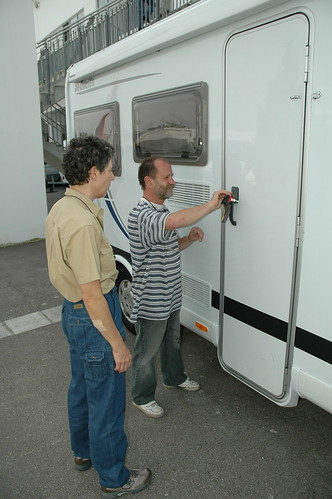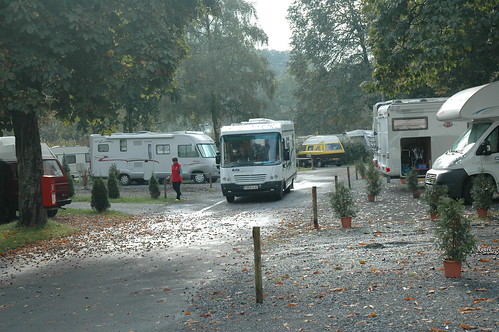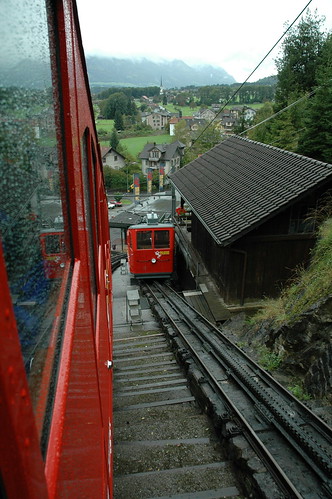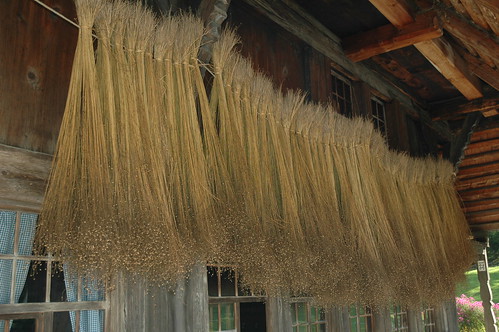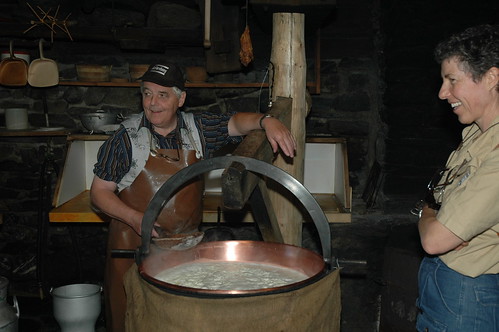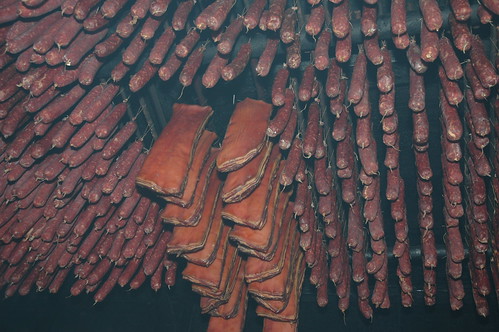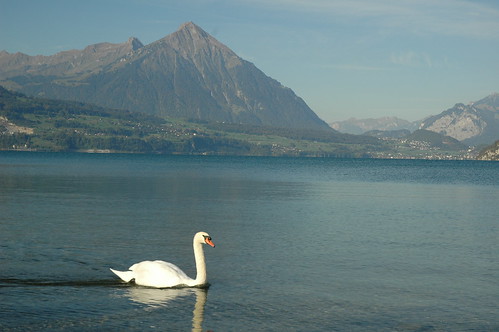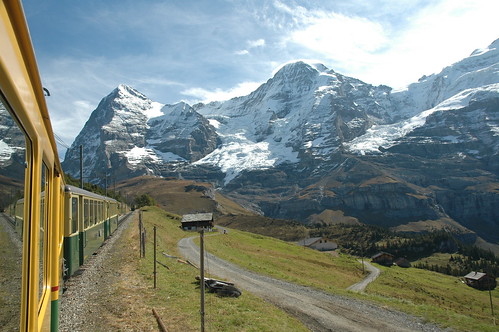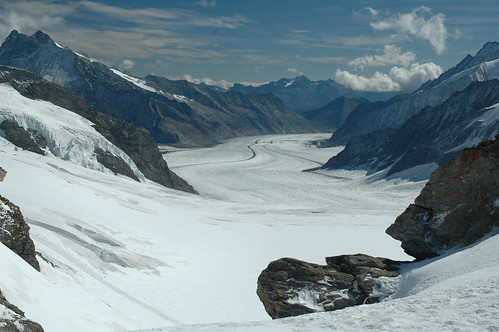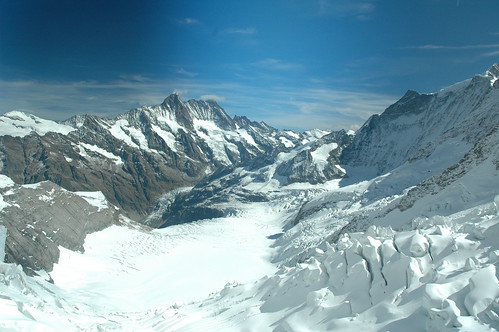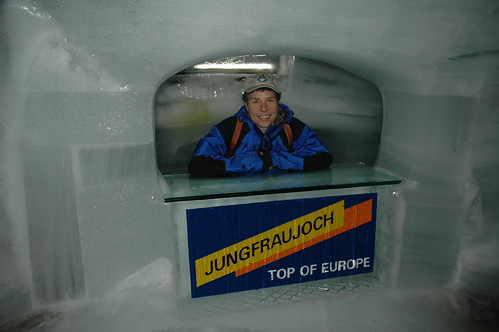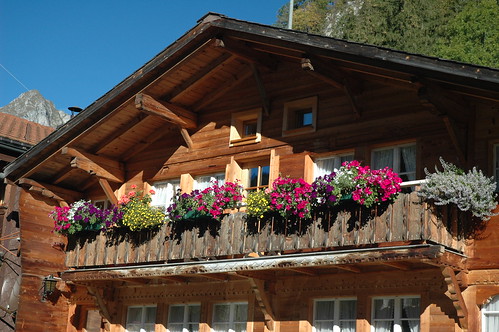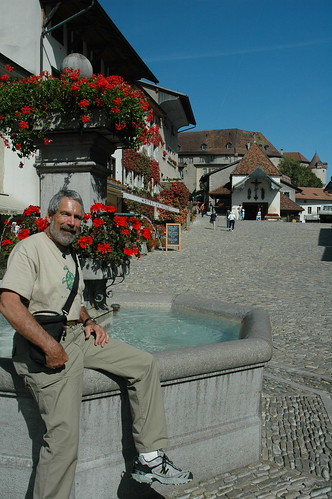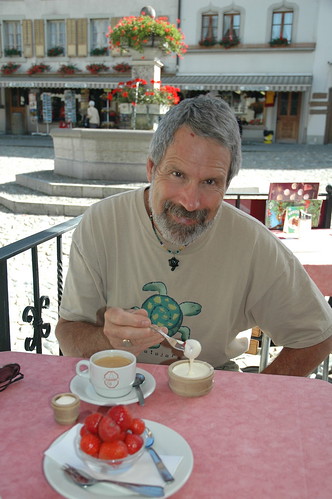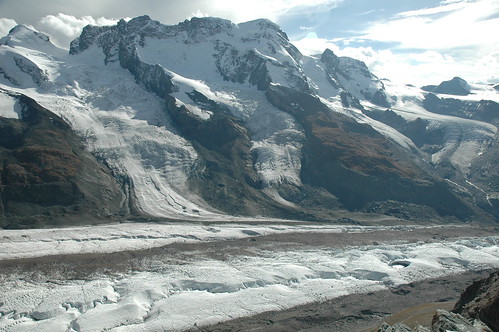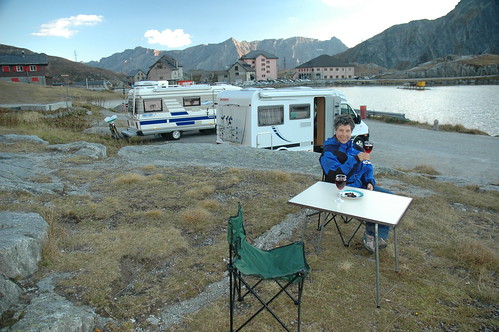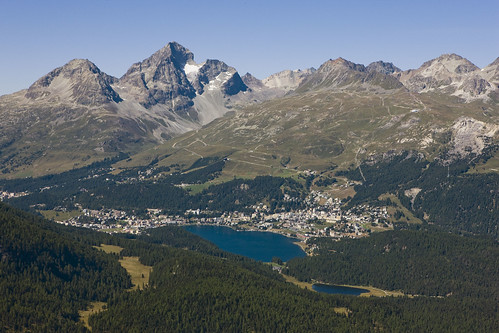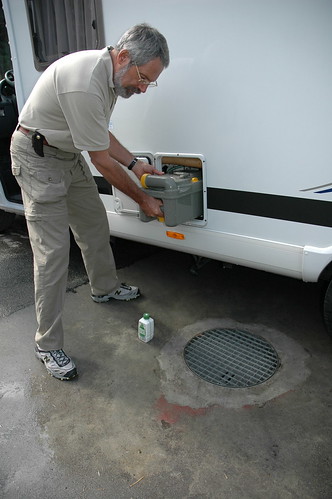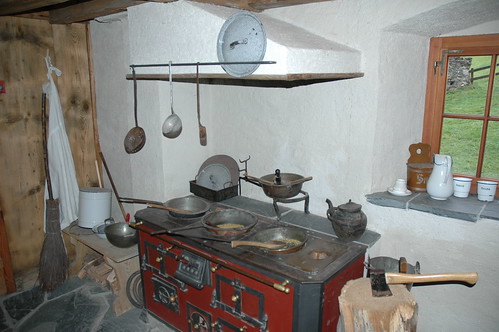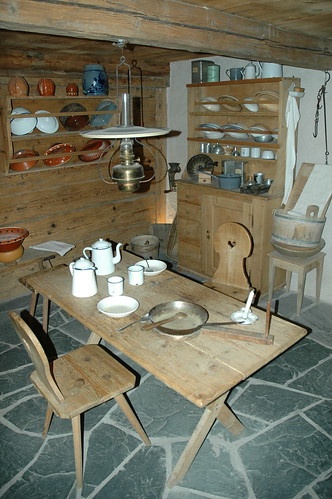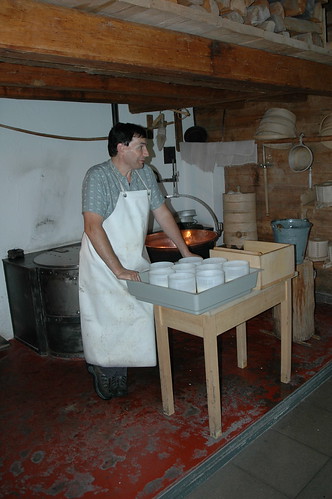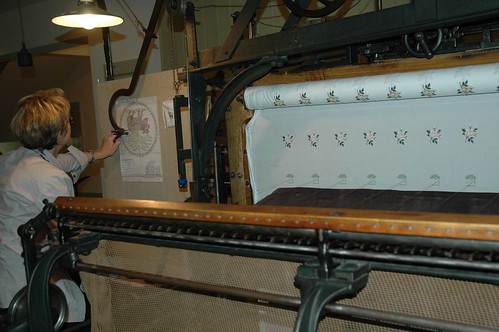Switzerland by RV – 2007
SWITZERLAND BY RV
Touring the Beautiful Land of Cheese and Chocolate
by Gary Wescott photos by Gary & Monika Wescott
Europeans have known the advantages of renting a motorhome and touring for decades. Every year hundreds come to enjoy our National Parks and campgrounds. We wondered, how easy would it be to fly to Europe, rent a little motorhome, and make a carefully planned ten-day tour of Switzerland, one of the most beautiful and tourist-friendly countries in the world. It was easier than we ever imagined!
Going to the Internet, we immediately found www.ideamerge.com. We were able to select the type and size vehicle we needed, mark the dates we would travel, check off any special equipment we wanted, and pay in U.S. Dollars with a credit card. Their comprehensive web site lists many books and excellent sources of information for RVing in Europe.
Next, we went to www.MySwitzerland.com and discovered virtually everything we didn’t already know about Switzerland. Admittedly, we had an advantage, since we had traveled extensively in Switzerland by car, train, and with our own motorhome. Our route was designed to hit some of the must-see places. As we studied the map, we were already wishing we had twenty days instead of ten.
Our flight from San Francisco touched down in Munich, Germany five minutes early. Following the instructions supplied to us by IdeaMerge, we took the train and then bus to the huge RV sales and rental facilities in Sulzemoos, just northwest of Munich. We could have taken a shuttle or taxi from the airport, but part of our goal was to keep costs as low as possible.

RV rentals are very popular in Europe. McRent outside of Munich has a good selection of small motorhomes.
Peter Schütz at Reisemobilvermietung had our Dethleffs Globebus T clean and waiting for us. After a brief introduction to its various locks and functions, like the cassette toilet, the heater, and the 3-way refrigerator, we were on the road. The McRent RVs come with a long list of necessary equipment, including electrical cords & adapters, cooking utensils, dishes, and silverware. Camping table, chairs, bedding, and towels were available at a small charge. We brought some of these from home. There was a very complete camping/RV/outdoor superstore adjacent to the rental pick-up office where we found several items to make our trip more fun.
Day 1
We had previously loaded a Lowrance GPS iWay 250 with the detailed maps for all of Western Europe. Entering our first destination, we headed south on the German Autobahn. The little Fiat turbo diesel hummed right along at 130 km/h, (80 mph), with still power to pull around slower vehicles, keeping a watchful eye for a BMW or Mercedes coming up from behind at 120 mph. In both Germany and Switzerland, you are not allowed to pass in the slow lane.
We zipped through the German/Austrian border near Bregenz, and crossed into Switzerland at St. Margrethen, stopping only to buy the mandatory Swiss Autobahn sticker, (40 sFr.). Our first night camp on Lake Constance, (Bodensee), gave us time to arrange things and study our proposed route. By using the excellent Swiss Autobahns some of the time, we could cover distances quickly between major points of interest.
Day 2
Getting an early start, we drove on the high-speed Autobahn,(N1), missing most of the congestion around Zurich, and arrived in the medieval city of Lucerne. Just outside the downtown center we joined other RVers in the modern Camping Lido RV Park, right on the shore of Lake Lucerne. From there we walked down the path to the dock and boarded one of the elegant steamers that ferry people around this beautiful lake, the fourth largest body of water in the country.
The scenery was breathtaking, and after several stops at small towns and villages, we arrived at our destination, Alpnachstad, the lower terminal for the Mt. Pilatus cogwheel railway, the steepest in
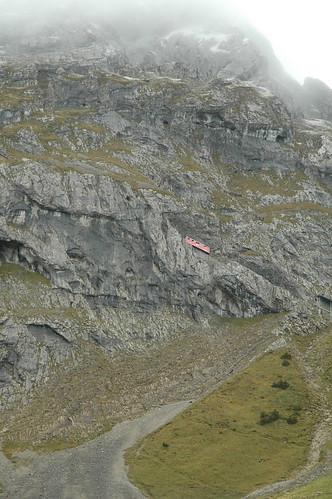
As the Mt. Pilatus clog wheel climbs up to the mountain peak above Lake Lucerne one can only be amazed at Swiss engineering.
the world with a 48% gradient. The panoramic view from the top of Mt. Pilatus, (6,994 ft.) encompasses Central Switzerland and no fewer than 73 mountain peaks. We had purchased tickets for the “Golden Round Trip”, which took us from our campground, by boat, cogwheel railway, aerial cable car, aerial panorama gondola, and finally by bus back to our home.
Day 3
Founded in 1178, days could be spent in the historical city of Lucerne, exploring its fortress walls and museums. With our limited schedule, we took time to sip a glass of wine at one of the Reuss River outdoor cafés that overlook the famous Chapel Bridge. Built in 1333 and adorned with paintings by St. Mauritius and St. Leodegar, its patron saints, it is one of the most treasured landmarks in the country.
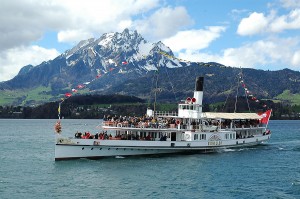
If climbing mountains is not your cup of tea, there is always a cable car or gondola to take you to the top of Switzerland’s most beautiful peaks. ® Switzerland Tourism: swiss-image.ch/Christof Sonderegger
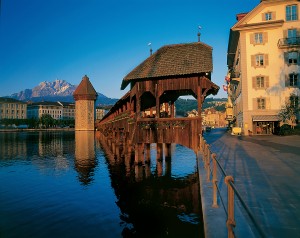
The historic covered bridge with its beautiful paintings has been completely restored following the tragic fire a few years ago. Mt. Pilatus can be seen in the background. ® Switzerland Tourism
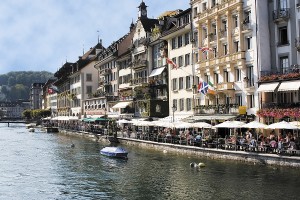
If you do nothing else in Lucerne, you must stop for a glass of wine at one of the quaint sidewalk cafés along the Reuss river, overlooking the famous Chapel Bridge. ® Luzern Tourismus AG: swiss-image.ch
Just a short drive south of Lucerne, we came to Ballenberg. This is a wonderful place to get a feel for both the traditions and the diversity of Switzerland. Actually a huge open-air living museum, typical houses from all corners of the country have been painstakingly dismantled and rebuilt. Many of the original breeds of farm animals have been retained, and the making of bread, sausage, cheese, chocolate, baskets, and other crafts are ongoing, just as they were hundreds of years ago.
Driving along the shore of Brienzer Lake, we arrived at our camp for this night at the scenic Camping Manor Farm on Lake Thun, the second of the twin Interlaken lakes. Feeling a little tired from a day of walking around Ballenberg, we splurged and enjoyed an excellent dinner at the Restaurant Neuhaus, just next door and right on the water’s edge.
Day 4
In the morning we sipped coffee on the beach and watched the sunrise as swans drifted by.

In the morning we sipped coffee on the beach at Campground Manor Farm and watched the sunrise over Lake Thun.
Tearing ourselves away from the postcard scenery of Interlaken, we headed still higher into the Alps. Our compact Globebus was no BMW, but it handled the corners very confidently, and with its 5-speed manual transmission coupled to the torquey diesel, it climbed like a little goat.
Arriving in Lauterbrunnen, we were in for a special treat. Locals were just bringing their livestock down from the summer pastures in the mountains, a traditional pageantry that dates back centuries. Cows were decorated with flowers and each proudly wore her bell. Men and women came in their traditional dress as they paraded though the streets.
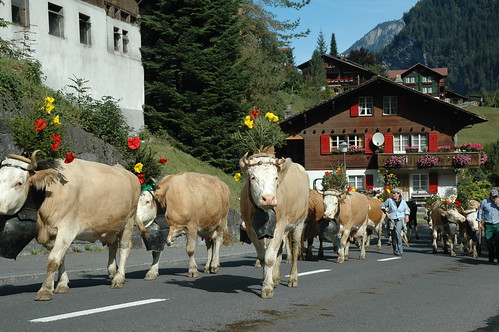
We were lucky enough to witness the cows parading down into the village from the summer pastures. It is always a festive occasion.
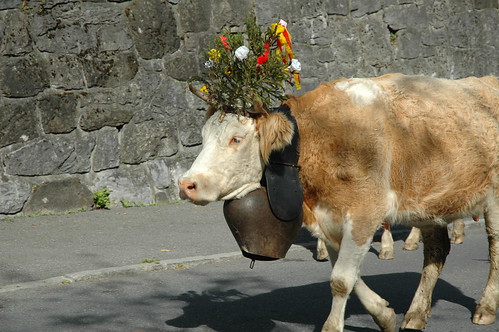
As cows are brought down from the alpine pastures, the lead cow traditionally carries the biggest bell.
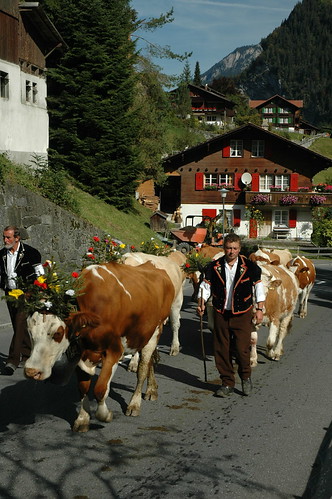
Cows were decorated with flowers and each proudly wore her bell. Men and women came in their traditional dress.
We found safe parking a few blocks from the train station, and climbed aboard the Wengen railroad which took us to Kleine Scheidegg, located beneath the towering peaks of the Eiger, Mönch, Jungfrau, and Gspaltenhorn. Here we boarded the Jungfrau railway, Europe’s highest cogwheel train, climbing to Jungfraujoch and the Top of Europe, (a UNESCO World Heritage site).
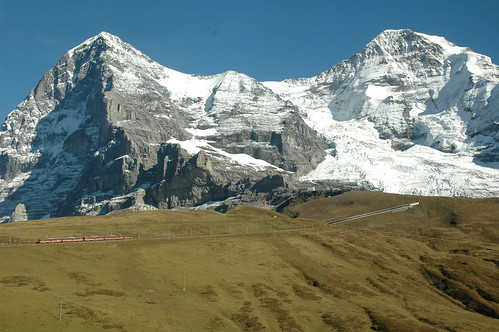
The Jungfrau Train offers spectacular views of the three famous Swiss Mountains Eiger with its North Face, Mönch and Jungfrau.
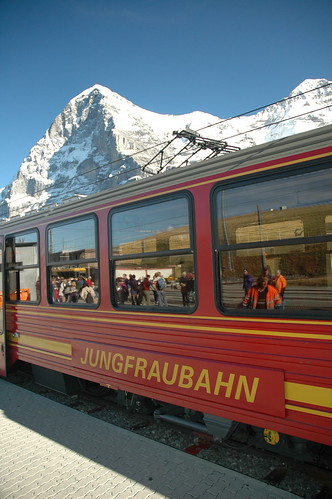
The narrow gauge Jungfraubahn (train) climbs into Eiger and makes a 160 degree turn inside the mountain on its way to The Top of the World at Jungfraujoch.
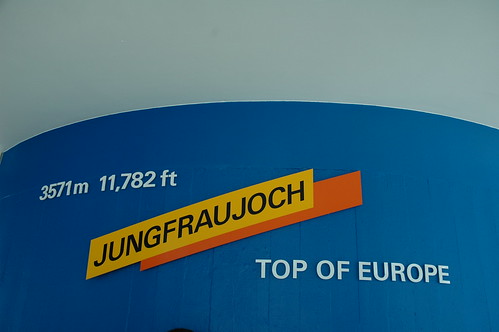
From the Sphinx look-out platform at Jungfraujoch at 11,782 ft., you can seen the peaks of Switzerland, Italy and France as well as the northern countries of German, Lichtenstein and Austria. The view was as breathtaking as the thin air.
The tracks make a 180-degree turn inside the mountain. From the Sphinx observation platform, 11,760 ft., the views of the Swiss, French, and Italian Alps, including the infamous North Face of the Eiger, and even parts of Germany, were as breathtaking as the thin air. We were surrounded by glaciers, one of which we could walk inside. The Great Aletsch Glacier, the largest in the Alps, covers more than 45 square miles as it flows over 14 miles into the Rhone Valley.
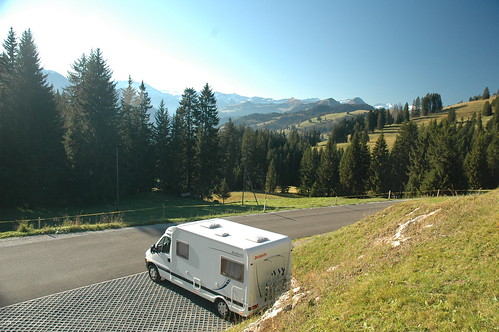
Little side roads can make quiet safe wild camps in the country. We stopped here just short of the Jaun Pass.
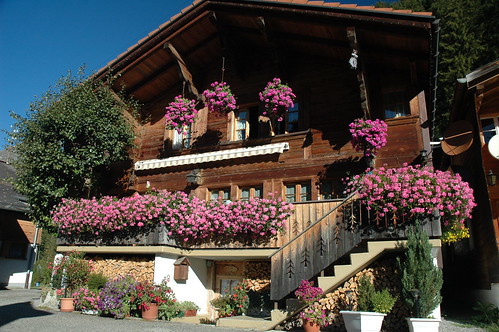
Despite our research we have not discovered how the Swiss get so many blooms off the common geranium.
There was still plenty of daylight left when we returned to our motorhome, so we retraced our route to Interlaken and headed east over the Jaunpass. Nearing the top we spotted a little side road and camped for a quiet night.
Day 5

Huge bags of cocoa beans were just one of the ingredients on display at the Cailler chocolate factory in Bulle.
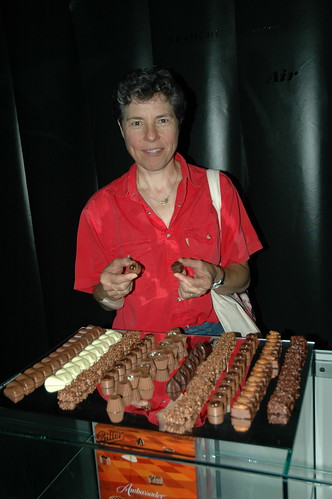
The limitless Cailler tasting room was scrumptiously delectable and fattening! How much chocolate can you eat at 10 AM???
No one ever suggested Switzerland was a place to lose weight. Our next stop, just up the road, was Gruyères, home of one of the country’s most delicious cheeses. Perched on a hilltop beneath an 11th century castle, this medieval town with its cobblestone streets and Market Square is well preserved. We stopped in Pringy at the entrance to Gruyères where an excellent cheese factory lets visitors watch the full process of making Gruyère Cheese. Seventy-five pound wheels are aged for 10 months or longer. As with all cheese made in Switzerland, (not to be confused with “Swiss cheese” made in other countries), milk comes from cows fed on natural fodder. Using additives for manufacturing and maturing is prohibited.
Continuing to Gruyères, we found ample parking in the lower lot #1. (The Visitors Center office told us that overnight stays are permitted.) Strolling up through the cobbled Market Square to the castle, we made our mandatory stop at one of the cute cafés to dip strawberries into a little wooden tub of double cream. You don’t want to know how many calories this has.
One of the joys of exploring Switzerland is that everything is so close. Leaving Gruyères, we scooted around to Vevey on Lake Geneva to visit the stunning Château de Chillon, one of the most impressive and imposing castles in Europe. History dates its first construction to the 11th century. Today, a Bishop, a Count, and a few wars later, it is still a classic, with towers & turrets, courtyards, prison gallows, dungeons, massive halls, stables, and of course, a moat, all framed by trees and the craggy mountains. We could have easily spent the rest of the day soaking up the atmosphere, but we did have a march route.
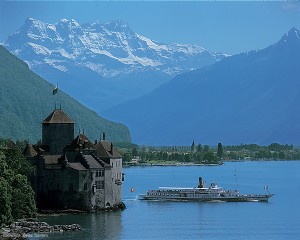
The 1000 year old Chateau de Chillon was made popular by Lord Byron, who wrote the poem, The Prisoner Of Chillon (1816), about François de Bonivard, a Genevois monk and politician who was imprisoned there from 1530 to 1536.
® Switzerland Tourism: swiss-image.ch/Christof Sonderegger
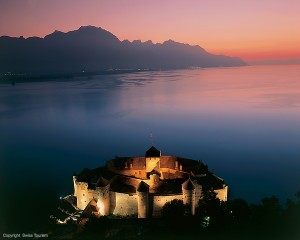
The amazing castle, Chateau de Chillon, near Montreux on the shores of Lake Geneva, dates back to more than a 1,000 years. ® Switzerland Tourism: swiss-image.ch/Christof Sonderegger
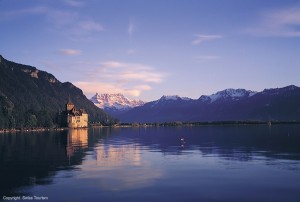
Dusk embraces Lake Geneva. In the background one can see the famous Chillon Castle with the Dents du Midi mountains. ® Switzerland Tourism: swiss-image.ch/Stephan Engler
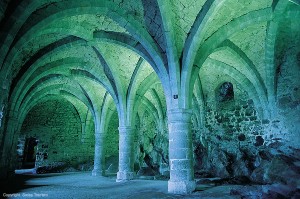
The Dungeons dating from the 12th century at the Chillon Castle on Lake Geneva lay below the lake’s water level. In the early 20th century it still served as a prison. ® Switzerland Tourism: swiss-image.ch/Stephan Engler
Taking the Autobahn, we drove south through Martigny and northeast to Sierre and Visp, where we turned south again on a windy secondary road to the famous town of Zermatt beneath the imposing ramparts of the Matterhorn. Actually, Zermatt is an alpine village without cars. Arriving just at dusk, we pulled into the only campground available in Täsch, a rather shabby RV park by Swiss standards, but conveniently located right next to the train station from which we would depart in the morning to reach Zermatt.
Day 6
France has the Eiffel Tower, Italy the Leaning Tower of Pisa – and Switzerland? The Matterhorn. At 14,691 feet, it is the world’s most spectacular and most-photographed mountain, and the life’s dream of many climbers. The Matterhorn is unique, but it’s not alone. Zermatt is dwarfed by 37 other 4,000 meter-plus peaks.
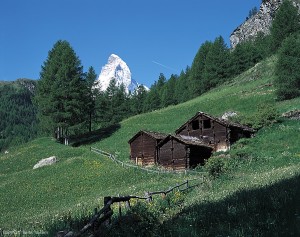
The area around Zermatt offers beautiful trails wandering through alps with weathered slate roofed homes.
® Zermatt Tourism/Ch. Sonderegger
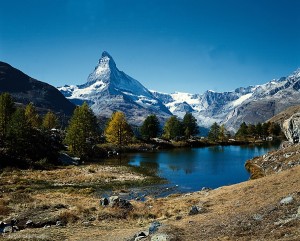
4,000 meter-plus peaks, including the Matterhorn, surround the Alp village of Zermatt. ® Switzerland Tourism
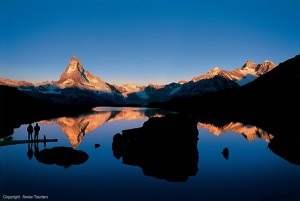
The vantage points to view the classic peak of the Matterhorn, the most photographed in the World, are as endless as the constantly changing light. ® Zermatt Tourism
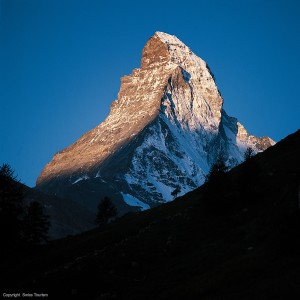
Sipping wine on the terrace of a cozy café, we watched the final alpenglow bathe the Matterhorn. ® Zermatt Tourism
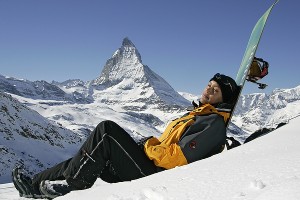
Skiers and snow boarders relax on the slopes above Zermatt, shadowed by the famous Matterhorn peak. ® Valais Tourism: swiss-image.ch/Thomas Andenmatten
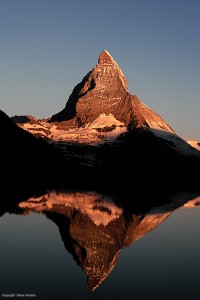
It is Switzerland’s most famous landmark, the most beautiful mountain in the world and considered by many true mountaineers to be the peak of all peaks: the Matterhorn (4478m), Zermatt in Canton Valais. ® Valais Tourism
We had been to Zermatt several times, and wanted to see the Matterhorn from a different angle, so we took the aerial tram and then two gondolas to the top of Klein Matterhorn or the “Little Matterhorn”. This is the highest sightseeing platform in the Alps, at 12,739 feet. It felt like we were looking down on the Matterhorn as we gazed over the panorama of Swiss, Italian and French peaks. Here too is the jump-off for year-round skiing on several glaciers. We didn’t have our skis, so we settled for a walk into the Ice Palace. A tunnel has been bored deep into the glacier, with ice exhibits and even an ice bar. Cold wine anyone?
Returning to the valley floor, we enjoyed a delicious lunch on the outside patio of the Restaurant Walliserhof. It was a great place to watch people strolling up and down main street.
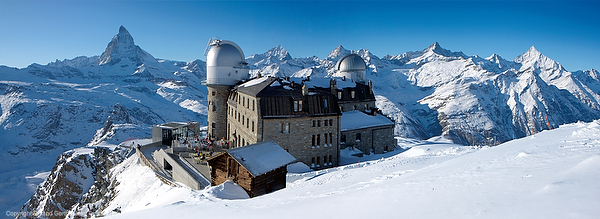
The view from the 3100 m Kulmhotel Gornergrat high above Zermatt is spectacular. In the background you can see the Matterhorn (4478 m). ® Switzerland Tourism/Roland Gerth
We still had time to board the cogwheel train up to the Gornergrat restaurant and hotel complex. This is the classic viewpoint of the Matterhorn. The Kulmhotel is the highest in the Alps at 10,170 feet.
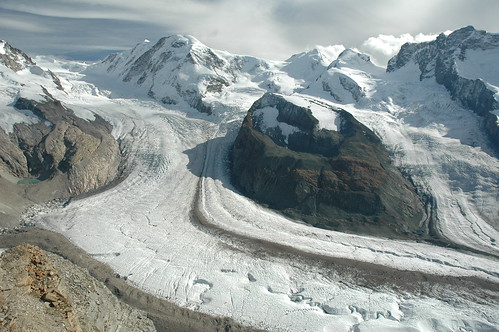
The mountains above Zermatt are laced with beautiful glaciers. They have definitely receded tremendously since our last visit a few years ago.
In Swiss style, we hiked down from the Gornergrat. Well-marked trails lead all the way to town. To our left, we were at eye level with at least six glaciers. It was shocking to notice how far they had receded since our last visit.
Day 7
Returning to Visp, we headed east to Brig where we made a little side trip over the beautiful Simplon Pass. There were dozens of ideal wild camping areas, and many RVs like our own were parked and picnicking. Our destination was the town of Simplon, famous for the special cheese used in a traditional Swiss specialty called Raclette, in which it is melted over potatoes. Don’t even think about Nachos!
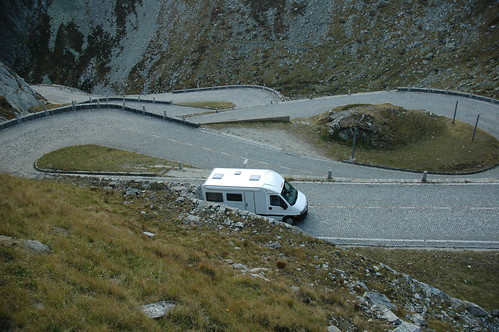
Serpentine switch-backs drop into the Tremola gorge as we climb toward the Gotthard pass, one of Switzerland most important and famous.
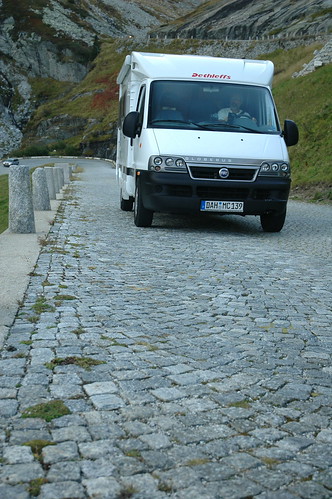
Our tires thump-a-the-thumped over the serpentine cobble stone road climbing over the historic Gotthard pass.
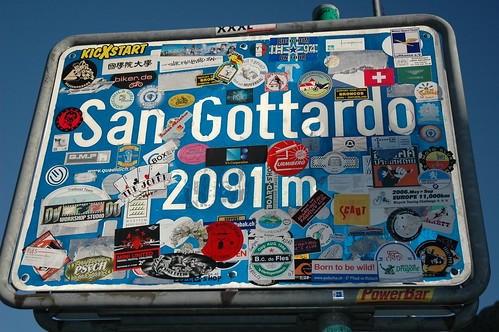
Beneath a full moon rising above Gotthard Pass, fellow campers serenaded us with the eery sounds of the classic Alphorn.
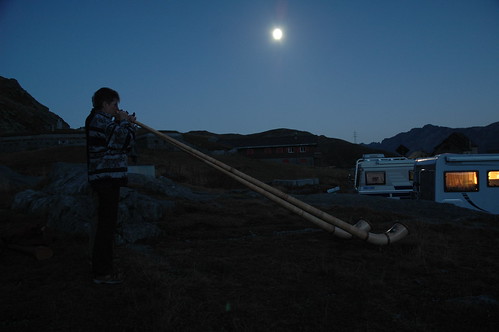
Beneath a full moon rising above Gotthard Pass, fellow campers serenaded us with the eery sounds of the classic Alphorn.
Back in Brig, we followed the Rhone River to the turnoff for Nufenen Pass, continuing down the Bedretto Valley along the Ticino River. At length, we came to Airolo and the southern start of the famous St. Gotthard Pass, perhaps the most historically important in all of Europe. There are tunnels and highways now, but we followed the original tortuous cobblestone route through the Tremola Gorge.
The fascinating museum at the top is worth several hours. The setting was incomparable, and we decided to camp with other RVers. The couple parked near us were accomplished Alp Horn musicians, and they played several songs beneath a full moon. It was magical!!
Day 8
Staying on the more relaxed and scenic secondary highways now, we drove over several passes, finally winding our way over the Julier Pass, which dropped us into the spectacular Engadin Valley and the town of St. Moritz, site of the 1928 and 1948 Winter Olympics. This is where the rich and famous play. In the high season, you may be able to find a nice room for less than $5,000 a night. Fortunately, there is a wonderful RV park, the Campingplatz Olympiaschanze, just outside of town, within easy access of the glitter and glamour.
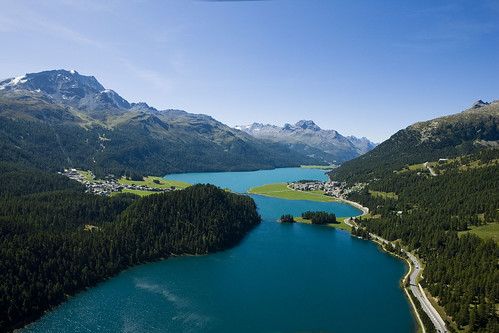
We stopped to admire the view of the famous Engadin valley before driving into St. Moritz. ® Switzerland Tourism: swiss-image.ch/Lucia Degonda
Like many RV parks in Switzerland, there were no specific sites, and no “hook ups” as Americans know them. We just picked a nice grassy place and ran our electrical cord out to the nearest junction box. There were very clean, modern restrooms and showers, a laundromat, a dump station for the universally used cassette toilets, a drain for grey water, and a water fill station.
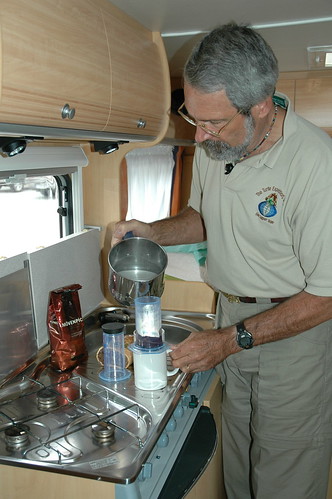
Gary brews a cup of fresh coffee in the efficient kitchen of the Globebus RV. The little Aero Press coffee maker was the ideal traveling companion. www.azuremoon.com
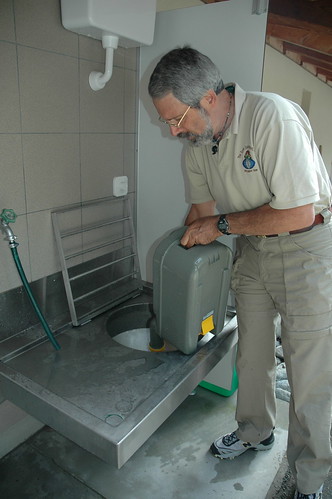
Virtually all RVs in Switzerland use the convenient cassette type toilets. RV parks have specialized dump stations for these.
From skin diving to mountain climbing, there is not room here to list all the activities available in and around St. Moritz. We spent a day shopping and exploring this wonderfully diverse and very tourist oriented town.
Day 9
The clock was ticking as we made our way down the scenic Engadin Valley. Our luck with the weather was running out. Weather is never totally predictable in Switzerland. This was only September 25th, and we were seeing snow on the ground when we reached the village of Susch, (4,680 ft.) The 7,818 ft. Flüelapass toward Davos was just ahead, and we didn’t have chains. No problem. We took the easy way, and loaded our motorhome onto the train for a relaxed trip through the Vereina Tunnel, under the mountain. Gotta love those Swiss tunnels!
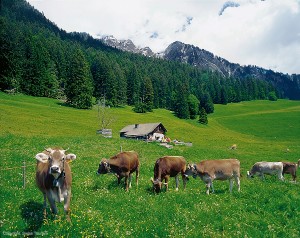
This is mountain summer pasture called Heidi Alp where Heidi actually stayed with her grandfather. ® Switzerland Tourism: swiss-image.ch/Christof
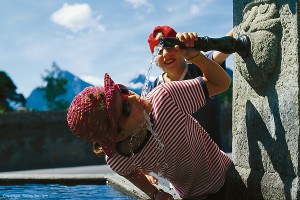
Almost every village in Switzerland has a drinking fountain. This one outside Maienfeld is dedicated to Johanna Spyri (1827-1901), the author of the world famous book Heidi. ® Switzerland Tourism
Heidi’s Village was our next stop just outside Maienfeld. The heartwarming story by Johanna Spyri of the young girl who lived with her grandfather in the Alps is by far the most popular work of children’s Swiss literature and has been translated from German into 50 languages, and filmed more than a dozen times. Over 50 million copies of Heidi books have been sold worldwide, (Switzerland’s population is only 7 million.). The actual house where Heidi lived has been turned into an interesting museum.
In a light rain, we jumped on the Autobahn and took the turnoff to Appenzell, a land of rolling green hills dotted with small farms, which produce the rich milk to make the famous spicy Appenzell cheese. The picturesque town is a must if you’ve never been to Switzerland, and the excellent Appenzell Demonstration Cheese Dairy in Stein is fascinating not only for its cheese.
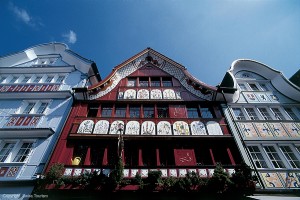
Typical houses line the streets in the picturesque town of Appenzell. ® Schweiz Tourismus: swiss-image.ch/Renato Bagattini
Next door, the Appenzell Folklore Museum has live demonstrations at an antique loom and an amazing embroidery machine. Real cheese was being made in an authentic cow-herder’s hut. We found a peaceful RV park just outside Appenzell and settled in for our last night in Switzerland.
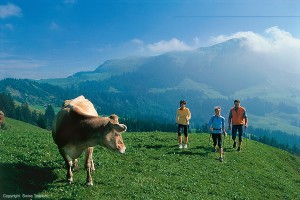
Hiking through the rolling hills and mountains of Switzerland is a favorite pastime of both Swiss and foreign tourists. Friendly cows don’t seem to mind the company. ® swiss-image.ch/Christof Schuerpf
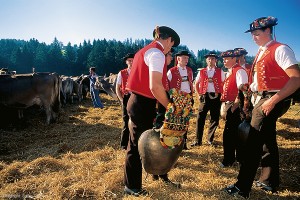
Appenzell farmers in their traditional dress participate in the ringing of the cow bells at an annual event. ® Switzerland Tourism: swiss-image.ch/Roland Gert
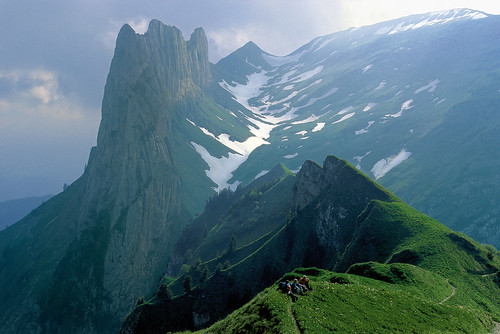
Hiking trails wind their way through the stunning Kreuzberge in the Alpstein massif in Eastern Switzerland. This is one of Monika’s favorite regions. ® Switzerland Tourism: swiss-image.ch/Roland Gerth
Day 10
Back on the high-speed Autobahn through Austria and into Germany, we had dropped off our motorhome by noon and were on the way back to the airport. It had been an amazing whirlwind tour, and we knew that we had only scratched the surface of Switzerland. Of course we’ll be back!
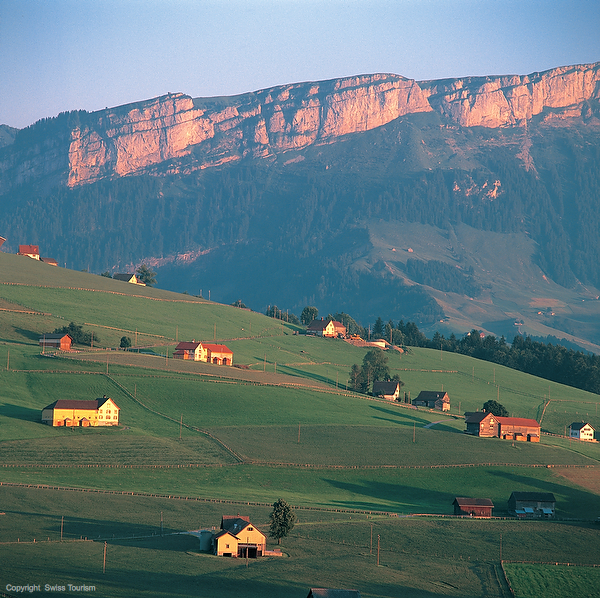
Small farms dot the rolling hills surrounding the Appenzell region famous for its spicy cheese. ® Schweiz Tourismus: swiss-image.ch
Useful Tidbits:
Language: Not a problem. Virtually everyone you will meet as a tourist will speak some English.
Driving: Swiss drivers are very polite, if a little frantic. Speed limit on the Swiss Autobahn is 130 Km/h (80 mph) unless otherwise posted. The speeds on secondary roads vary frequently and there are many photo speed traps. Get a good map before you start. Sometimes the GPS does not know the best way. Frequent roundabouts in town can be exciting. Highways are well marked. “Ausfahrt” means “Exit”, and has nothing to do with your intestinal track. Our total mileage for the 10-day trip was 1,085.
Fuel: Modern gas/diesel stations are everywhere. Our total fuel costs were $409.00 U.S. Diesel is about $5.65 a gallon. (September 2007)
Money: Swiss Francs, Euros, and major credit cards are all widely accepted in Switzerland. U.S. Dollars are easy to change at train stations and banks. Upon arrival in the airport, where there are “change booths”, get some Euros and Swiss Francs, including some 1 and 2 Swiss Franc coins for parking meters and to unlock shopping carts. $100 bucks should get you started.
Food: Supermarkets are everywhere, and the small bakeries, butcher shops and cheese stores are a real treat. We like good coffee, so we packed our own little Aero Press, www.azuremoon.com, coffee maker for use on the road.
RV Tips: Choose the smallest unit you can feel comfortable in. You will be very glad on the narrow roads through villages and over passes! Make sure you fully understand how everything works before you start your trip! Grey water is emptied in RV parks. Black water is universally contained in Thetford-type cassette toilets, which can be emptied in RV dump stations or public restrooms in a pinch. The cassette in our Globebus was good for a little over two days. Water is safe and available everywhere. The average cost of RV campgrounds is about 25 sFr., or $23.00 U.S.
SOURCES
Ideamerge
888 297-0001
www.ideamerge.com
McRent
www.mcrent.de
Switzerland Tourism
310 260-2421
www.myswitzerland.com








